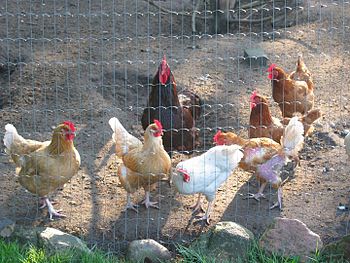
Feather pecking is a behavioural problem that occurs most frequently amongst domestic hens reared for egg production,[1][2] although it does occur in other poultry such as pheasants,[3] turkeys,[4] ducks,[5] broiler chickens[6] and is sometimes seen in farmed ostriches.[7] Feather pecking occurs when one bird repeatedly pecks at the feathers of another. The levels of severity may be recognized as mild and severe.[8] Gentle feather pecking is considered to be a normal investigatory behaviour where the feathers of the recipient are hardly disturbed and therefore does not represent a problem. In severe feather pecking, however, the feathers of the recipient are grasped, pulled at and sometimes removed. This is painful for the receiving bird[9] and can lead to trauma of the skin or bleeding, which in turn can lead to cannibalism and death.
Feather pecking is one of the major problems facing the egg industry in non-cage systems and is set to become an even greater issue with the EU legislation (Council Directive 1999/74/EC)[10] ban on the keeping of laying hens in barren battery cages which came into force in 2012, and the prospect of a ban on beak-trimming (see below). Reducing feather pecking without resorting to beak-trimming is an important goal for the poultry industry.
- ^ Huber-Eicher, B. and Sebo, F. 2001. The prevalence of feather pecking and development in commercial flocks of laying hens. Applied Animal Behaviour Science, 74: 223–231
- ^ Sherwin, C.M., Richards, G.J and Nicol, C.J. 2010. A comparison of the welfare of layer hens in four housing systems in the UK. British Poultry Science, 51(4): 488-499
- ^ Butler, D.A. and Davis, C. 2010. Effects of plastic bits on the condition and behaviour of captive-reared pheasants. Veterinary. Record, 166: 398-401
- ^ Sherwin, C.M., 2010. Turkeys: Behavior, Management and Well-Being. In “The Encyclopaedia of Animal Science”. Wilson G. Pond and Alan W. Bell (Eds). Marcel Dekker. pp. 847-849
- ^ Gustafson, L.A., Cheng, H.W., Garner, J.P., et al. 2007. Effects of bill-trimming Muscovy ducks on behavior, body weight gain, and bill morphopathology. Applied Animal Behaviour Science, 103: 59-74
- ^ Girard, Ms. Teryn E.; Zuidhof, Martin J.; Bench, Clover J. (2017). "Feeding, foraging, and feather pecking behaviours in precision-fed and skip-a-day-fed broiler breeder pullets". Applied Animal Behaviour Science. 188: 42–49. doi:10.1016/j.applanim.2016.12.011.
- ^ Reischl, E. and Sambraus, H.H. 2003. Feather-pecking of African ostriches in Israel. Tierarztliche Umschau, 58: 364-369
- ^ McAdie, T.M. and Keeling, L.J. 2002. The social transmission of feather pecking in laying hens: effects of environment and age. Applied Animal Behaviour Science, 75: 147-159
- ^ Gentle, M.J. and Hunter, L.N. 1991. Physiological and behavioural responses associated with feather removal in Gallus gallus var domesticus. Research in Veterinary Science, 50: 95-101
- ^ "COUNCIL DIRECTIVE 1999/74/EC of 19 July 1999 laying down minimum standards for the protection of laying hens". Official Journal of the European Communities. 3 March 1999. Retrieved 2017-02-24.
